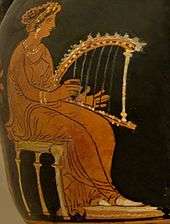Psaltery


A psaltery is a stringed instrument of the zither family.
Ancient harp psaltery
The psaltery of Ancient Greece (epigonion) is a harp-like instrument. The word psaltery derives from the Ancient Greek ψαλτήριον (psaltḗrion), "stringed instrument, psaltery, harp"[1] and that from the verb ψάλλω (psállō), "to touch sharply, to pluck, pull, twitch" and in the case of the strings of musical instruments, "to play a stringed instrument with the fingers, and not with the plectrum."[2] The psaltery was originally made from wood, and relied on natural acoustics for sound production.
In the King James Version of the Bible, "psaltery", and its plural, "psalteries", are used to translate several words whose meaning is now unknown: the Hebrew keli (כלי) in Psalm 71:22 and I Chronicles 16:5; nevel (נבל) in I Samuel 10:5; 2 Samuel 6:5; I Kings 10:12; I Chronicles 13:8; 15:16, 20, 28; 25:1, 6; II Chronicles 5:12; 9:11; 20:28; 29:25; Nehemiah 12:27; Psalms 33:2; 57:6; 81:2; 92:3; 108:2; 144:9; and 150:3; and the Aramaic pesanterin (פסנתרין) in Daniel 3:5, 7, 10, and 15.
Ancient European zither psaltery
In the Christian era, a psaltery consisting of a soundboard with several pre-tuned strings that are usually plucked came into use. It was also known by the name canon from the Greek word κανών (kanṓn), which means "rule", "principle", and also "mode". The modern Greek folk instrument is called by its diminutive, kanonaki. The instrument is usually small enough to be portable; its shape and range vary.
Medieval psaltery

From the 12th through the 15th centuries, psalteries are widely seen in manuscripts, paintings and sculpture throughout Europe. They vary widely in shape and the number of strings (which are often, like lutes, in courses of two or more strings).
Modern psaltery
In the 19th century, several related zithers came into use, notably the guitar zither and the autoharp. In the 20th century, the bowed psaltery came into wide use. It is set up in a triangular format so that the end portion of each string can be bowed.
Similar instruments include the large cimbalom and the smaller dulcimer, both usually played using small hammers to hit the strings.
See also
Notes
References
-
 Chisholm, Hugh, ed. (1911). "Psaltery". Encyclopædia Britannica (11th ed.). Cambridge University Press.
Chisholm, Hugh, ed. (1911). "Psaltery". Encyclopædia Britannica (11th ed.). Cambridge University Press.
External links
| Wikimedia Commons has media related to Psaltery. |
- Psaltery
- Discussion of psalteries, with image from the exhibition Making Musical Instruments: The making of musical instruments in Canada by the Canadian Museum of Civilisation